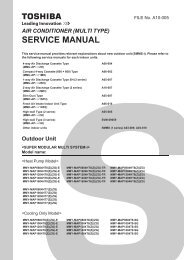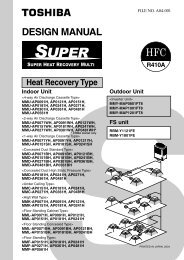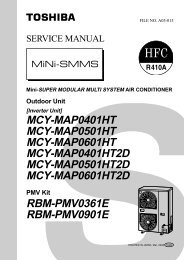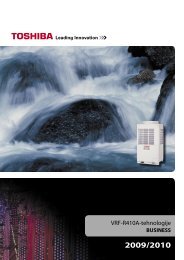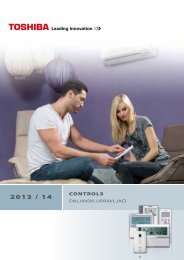Engineering Data Book - Toshiba
Engineering Data Book - Toshiba
Engineering Data Book - Toshiba
Create successful ePaper yourself
Turn your PDF publications into a flip-book with our unique Google optimized e-Paper software.
SMMS-i <strong>Data</strong> book7 Refrigerant piping design1. WARNINGS ON REFRIGERANT LEAKAGECheck of Concentration LimitThe room in which the air conditioner is to be installedrequires a design that in the event of refrigerant gasleaking out, its concentration will not exceed a set limit.The refrigerant R410A which is used in the airconditioner is safe, without the toxicity or combustibilityof ammonia, and is not restricted by laws to be imposedwhich protect the ozone layer. However, since itcontains more than air, it poses the risk of suffocation ifits concentration should rise excessively.Suffocation from leakage of R410A is almostnonexistent. With the recent increase in the number ofhigh concentration buildings, however, the installation ofmulti air conditioner systems is on the increase becauseof the need for effective use of floor space, individualcontrol, energy conservation by curtailing heat andcarrying power etc.Most importantly, the multi air conditioner system is ableto replenish a large amount of refrigerant comparedwith conventional individual air conditioners. If a singleunit of the multi conditioner system is to beinstalled in a small room, select a suitable model andinstallation procedure so that if the refrigerantaccidentally leaks out, its concentration does not reachthe limit (and in the event of an emergency, measurescan be made before injury can occur).In a room where the concentration may exceed the limit,create an opening with adjacent rooms, or installmechanical ventilation combined with a gas leakdetection device.The concentration is as given below.Total amount of refrigerant (kg)Min. volume of the indoor unit installed room (m 3 )≤ Concentration limit (kg/m 3 )The concentration limit of R410A which is used in multiair conditioners is 0.3kg/m 3 .NOTE 2:The standards for minimum room volume are as follows.(1) No partition (shaded portion)(2) When there is an effective opening with the adjacentroom for ventilation of leaking refrigerant gas(opening without a door, or an opening 0.15% orlarger than the respective floor spaces at the top orbottom of the door).(3) If an indoor unit is installed in each partitioned roomand the refrigerant tubing is interconnected, thesmallest room of course becomes the object. Butwhen a mechanical ventilation is installedinterlocked with a gas leakage detector in thesmallest room where the density limit is exceeded,the volume of the next smallest room becomes theobject.Refrigerant pipingVerysmallroomSmallroomImportantMediumroomOutdoor unitRefrigerant pipingLarge roomIndoor unitOutdoor unitIndoor unitNOTE 1:If there are 2 or more refrigerating systems in a singlerefrigerating device, the amounts of refrigerant shouldbe as charged in each independent device.e.g., chargedamount (10kg)Outdoor unite.g.,charged amount (15kg)Room A Room B Room C Room D Room E Room FIndoor unitFor the amount of charge in this example:The possible amount of leaked refrigerant gas inrooms A, B and C is 10kg.The possible amount of leaked refrigerant gas inrooms D, E and F is 15kg.Mechanical ventilation device - Gas leak detectorNOTE 3:The minimum indoor floor area compared with theamount of refrigerant is roughly as follows: (When theceiling is 2.7m high)Min. indoor floor area40m² 35302520151050Range below thedensity limit of0.3 kg/m 3(countermeasures not needed)Range abovethe density limitof 0.3 kg/m 3(countermeasures needed)10 20 30Total amount of refrigerantkg7 -1



